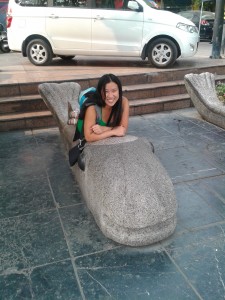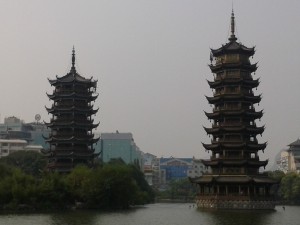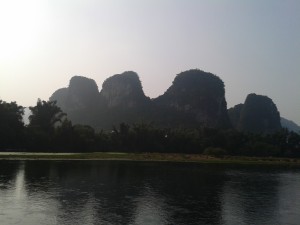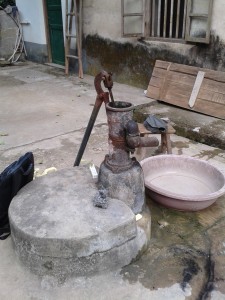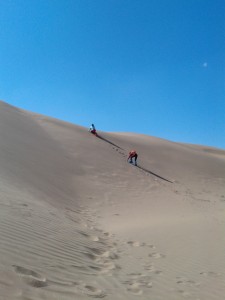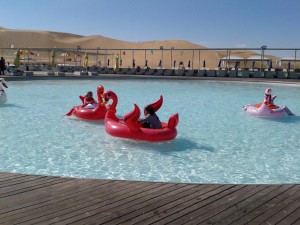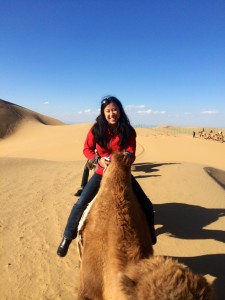Every semester, IES organizes a mobile learning trip for each program. We go with our teachers to other places in China besides Beijing and practice Chinese while we are traveling. Since my program has so many people we got two trips to chose from. We could either go to Guangxi province or Guizhou province. Both of them are in the southern part of China and both of them are different than anywhere else in China that I’ve been so far.
I chose to go to Guangxi. It looks nothing at all like Beijing as far as the general landscape is concerned. It is greener, has lots of rivers, and has mountains everywhere. The most unique of them are the karats, which is a very unique type of mountain. Guilin in particular is famous for them. Guilin is tourist city, much like Beijing in that regard, but it is much smaller. We went to see the famous two pagodas on a lake and then tried to go see Elephant Trunk Hill but it was too expensive. And that is about the extent of the “famous” sites there, as opposed to Beijing which has hundreds of famous tourist sites. Nevertheless, the natural sites in Guilin, such as the Lijiang River, are well worth the trip. The water, surprisingly (if you’ve read about China’s rivers in history class that is), was very clear. I could see plants waving on the bottom of the rivers and tiny fish darting around. We even swam in a river in Yangshuo, another city in Guangxi. The locals though we were crazy to do it, but we just waved and smiled at them (well what else do you do in that situation).
We also stayed in three villages. One was called Longji. It is particularly famous for its terraced rice fields. If we’d come a few weeks earlier we could have seen them golden and full, but the rice had already been harvested. We did get to see them burning the unused stalks, drying out the raw rice, and prepping the fields for the next season. The people working the fields were primarily minority people. In Longji, they were mostly Zhuang minority. This is the largest minority in Guangxi province. They have their own clothes, food, songs, language, and holidays. Many of these traditions are maintained by the older generation because most of the young people have gone to cities for education or are only learning Mandarin to prepare for a better life.
Our second village was about half Zhuang minority and half Yao minority. Yao minority people have their own unique traditions and customs as well. The long hair of the Yao women is particularly famous. They only cut their hair once a year because they believe that long hair signifies long life. They keep their current hair and last years hair together wrapped around their head for practicality. These women are anything but stay at home moms; on the contrary, they are in quite good shape. They hike up and down the mountains and rice terraces hauling heavy loads on their backs in baskets.
Our last village was the most different of them all because it was a farm village. They had traditional houses and very minimal modern technology. If they wanted to eat chicken, they had to kill one. They used old tools to dig up their crops, and so did we when we dug up sweet potatoes during our stay. They don’t have machines to help take their yellow beans out of their pods; they do it by hitting the pods with a large stick. Once they collected all the beans up in a dust pan, we helped them sort the good from the bad by hand. The good ones can be used to make tofu; the bad ones we threw at each other behind each other’s backs. Don’t blame us. The teachers started it. We learned a lot about minority groups and rural people on this trip, but what we also learned a lot about each other. In the natural beauty that is Guangxi we all bonded in a way that would be impossible in Beijing. There’s nothing like digging up sweet potatoes, hiking for six hours through the terraced rice fields, and swimming in a river to bring people together.
